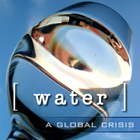
|
SHIJIAZHUANG, CITY OF 2 MILLION, FAST RUNNING OUT OF WATER, HAS LITTLE PLANNING TO FACE IMMINENT CHRONIC DROUGHT 28 September 2007 Shijiazhuang, a city of 2 million on the North China Plain saw 11% growth last year, is undergoing a population and construction boom, and is inviting new residents with money to spend to inhabit water-intensive luxury housing, even as irreplaceable aquifers are drying up, and water tables are dropping at alarming speed. China's north and northwest are suffering sever hydrological strain, and poor planning could lead to environmental degradation on a scale that would spur the collapse of the entire national economy. Some analysts believe it is already too late for anything other than remedial measures. As the International Herald Tribune reports, "China is scouring the world for oil, natural gas and minerals to keep its economic machine humming. But trade deals cannot solve water problems. Water usage in China has quintupled since 1949, and leaders will increasingly face tough political choices as cities, industry and farming compete for a finite and unbalanced water supply". Sustaining the level of irregular economic growth and breakneck industrial development will mean consuming resources far beyond what its territory can provide and its population can produce, which means China must face stiff competition in international markets as its growth becomes more unsustainable, but internal competition, for resources and general wellbeing, even for staples like water and grain, mean the situation is already critical. China now faces the reality of having not even the same water resources, but less available fresh water, due to aquifer depletion, but continually expanding demand, from construction, industry, farming, and consumer use. The major dam project at the Three Gorges is indicative of China's Communist Party's traditional way of dealing with water problems: engineering solutions to redirect or overexploit existing resources. The North China Plain is home to more than 200 million people, but is facing chronic water shortages and a process of mounting desertification. The South-to-North Water Transfer Project, conceived by Mao but never realized, is now under construction and will cost an estimated $62 billion. It will redirect water along 3 routes from the Yangtze River to the North China Plain and Beijing and is not expected to be complete until the year 2050. If the project is completed as planned, there are real concerns about widespread environmental degradation and calamitous ecosystem collapse, not to mention water stress, in the Yangtze basin. What China needs at present is a wholesale reformulation of its water policy, as scientists now believe fossil aquifers below the North China Plain will likely be fully drained within 3 decades, more than 10 years before the Water Transfer Project will be completed. [s]
BACKGROUND: Water is one of the "fundamental building-blocks of life", as is often said in science, in biology classrooms, in medicine, theology, environmental policy debates, and in cosmology and space exploration. It is also a commodity whose economic reality is increasingly defined by chronic scarcity and often intensely uneven distribution. One of the most vital problems regarding the global water supply is the fact that we are already over-exploiting it, draining vital fluvial systems and ancient underground aquifers that cannot be replenished. This, coupled with the population boom and increasing industrialization, urbanization and consumerization of emerging economies, means global scarcity is fast becoming the rule. [Full Story] DANUBE ADDED TO LIST OF MAJOR RIVERS IN DANGER OF DISAPPEARING How can a major river disappear? It is all too easy to thing this will never happen, that nature is in balance and will always find a way. But the reality is that nature replaced no-longer viable realities with others that can stand up to circumstance, and circumstance is stressing some major rivers beyond their capacity. The Danube is the latest to be added to a list of endangered rivers. [Full Story] WORLD’S WATER RESOURCES FACE MOUNTING PRESSURE Global freshwater use tripled during the second half of the twentieth century as population more than doubled and as technological advances let farmers and other water users pump groundwater from greater depths and harness river water with more and larger dams. As global demand soars, pressures on the world’s water resources are straining aquatic systems worldwide. Rivers are running dry, lakes are disappearing, and water tables are dropping. [Full Story] WORLD WATER DAY HIGHLIGHTS EFFECTS OF POVERTY, CLEAN WATER SCARCITY ON 1 BILLION WORLDWIDE Parts of east Africa have not seen rain for six years and six nations there are facing extreme famine. Through events organized by UNESCO, the UN and NGOs are hosting World Water Day today, to raise awareness of the problem of scarcity of safe drinking water affecting an estimated 1 billion people worldwide. [Full Story] AFRICA SUFFERS SPREAD OF FAMINE, HUNGER As the world begins to focus on the nearly 3 million facing hunger in Niger and the catastrophic refugee crisis in Darfur, in western Sudan, an estimated 31.1 million people across the continent face food shortages. Arable land, foodstocks and agriculture in general are suffering dangerous setbacks, making it increasingly difficult to feed African populations, some of which are growing rapidly. [Full Story] WORLD'S FRESH WATER RAPIDLY BEING DEPLETED, GLOBAL SHORTAGE FEARED The United Nations has been pushing for some time for a global strategy to deal with the looming scarcity of fresh water. A BBC report from June 2000 indicated 1 in 5 of all living human beings already lacks access to safe drinking water. Dramatically making the point that our oceans cannot solve the problem, the report says "Only 2.5% of the world's water is not salty, and two-thirds of that is locked up in the icecaps and glaciers." [Full Story]
|
|||||||||||||||||||||||||||||
|
||||||||||||||||||||||||||||||












